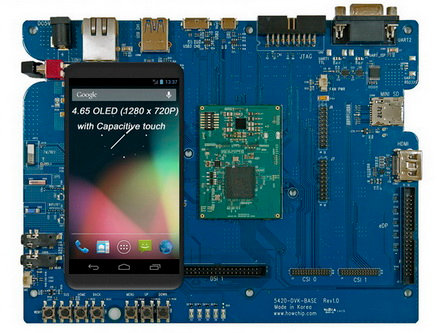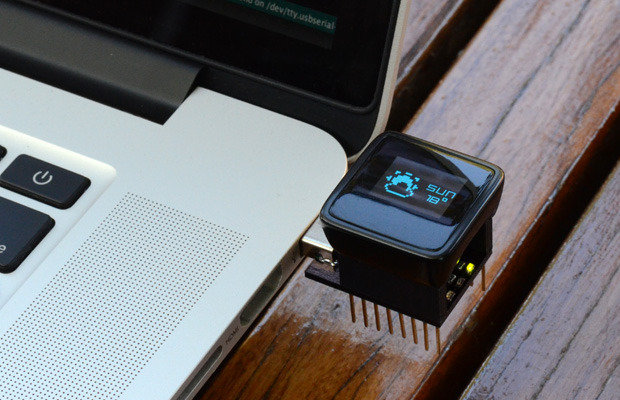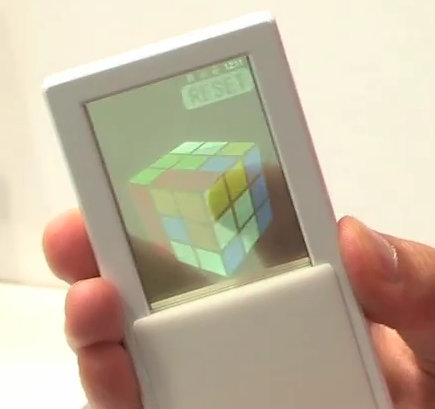Getting Wi-Fi with Arduino can be relatively expensive, and may take a little too much space. Spark Core board greatly addressed both price ($39) and form factor issue last, but there’s another option coming to market thanks to WifiDuino a $34 board with Wi-Fi, that’s tiny and Arduino compatible. An OLED display is also available as an option, at a lower price point than MicroView board, and including Wi-Fi or not, depending on the perk. WifiDuino hardware specifications: MCU – Atmel Atmega32U4 (same as Arduino Leonardo) Display – Optional 128×64 OLED display Connectivity – Optional Wi-Fi 802.11 b/g with STA, AP and ADHOC network modes Digital I/Os – 20 Analog I/Os – 12 Other I/Os – 7x PWM, UART, I2C, SPI Power – 5V Dimensions – Duino board only without Wi-Fi nor OLED: 25.6mm x 38.8mm x 11.0mm WifiDuino support the Arduino IDE, so you can write you sketch as […]
HOWCHIP 5420-DVK is a Mobile Development Kit with Samsung Exynos 5420 SoC, an OLED Display
With Arndale Octa already shipping, and the upcoming ODROID-XU2, we already have two low cost boards with Samsung Exynos 5420 big.LITTLE processor for less than $200. But if you want a more complete kit, HOWCHIP 5420-DVK with a 4.65″ OLED display and capacitive touchscreen, 2GB RAM, 4GB eMMC, and various connectors, could be an option. There’s also a Lite version without the OLED display. The board is composed of a CPU module, a baseboard, and a phone like display. Here are the specifications: SoC – Samsung Exynos 5420 Octa with 4x ARM Cortex A15, and 4x ARM Cortex A7 in big.LITTLE configuration, with Mali-T628 GPU. System Memory – 2GB LPDDR3 (POP with CPU) Storage – 4GB eMMC 4GB on board, SD card Slot Video Output HDMI type A connector MIPI DSI header up to 1980×1080 eDP (Embedded Display Port) header up to 2560×1600 Display – 4.65″ OLED (1280×720) with touch […]
MicroView is a Tiny Arduino Compatible Board with an OLED Display (Crowdfunding)
Last year, we’ve been presented with many small Arduino compatible boards such as MicroDuino, RFDuino, BLEDuino, Spark Core, Olimexino-Nano and more… All these boards have been own strength and connectivity options, but if you want to see what going on in your board, you’d either need to connect it to your computer, or connect some LEDs or an external display. Geek Ammo’s MicroView fixes that by providing an Arduino compatible board nicely combined with a built-in OLED display. This allows you to display stats, weather, play games, create wearable projects (watch, necklace), and all sort of other projects that may require a small display. MicroView specifications: MCU – Atmel ATmega328P @ 16 MHz with 32KB flash, 2 KB SRAM, and 1KB EEPROM Display – 64×48 OLED Display Digital I/O – 12 (of which 3 provide PWM output) Analog Input – 6 Operating Voltage: 5V Input Voltage: 3.3VDC to 16VDC, no […]
NTT Docomo Showcases Smartphone Prototype with See-through Touch Panel
NTT Docomo and Fujitsus have jointly developed a smartphone prototype with a 2.4″ see-through OLED display (QVGA) that has touch sensors both on its front and back sides and NTT Docomo is currently exhibiting the device and showcasing the corresponding new innovative user interface at Wireless Japan 2012, until June 1, 2012, in Tokyo. The backside touch panel can be operated by using the forefinger and there are several ways to take advantage of a see-through display in the UI including: Operate the notification bar from the back side of the panel with a finger Hold an icon with a finger of one hand from the back side of the panel and stroke the front side of the panel with a forefinger of the other hand to move the home screen on which the icon is placed Play Rubik’s Cube by spinning the cube when the back side is not […]
Samsung Super Amoled Plus Displays
Samsung further improved their Super AMOLED technology and designed “Super AMOLED Plus” screens with the following characteristics: Easier Reading: Improved screen image (50% more sub-pixels (8 to 12)) Save Power Consumption: Real Black (i.e no energy is used to display black) Slimmer: Reduced panel depth by 14% This new technology will improve contrast and outdoor visibility. Samsung will release 2 smartphones (Samsung Infuse 4G – i997) using that technology later this year (Q2 2011) with 4.3″ and 4.5″ screens, using 1.2 GHz single core hummingbird processor and running Android 2.3 (gingerbread). Jean-Luc Aufranc (CNXSoft)Jean-Luc started CNX Software in 2010 as a part-time endeavor, before quitting his job as a software engineering manager, and starting to write daily news, and reviews full time later in 2011. www.cnx-software.com
See-through OLED & LCD Displays
Samsung Electronics and LG exhibited see-through LCD displays and Samsung Mobile Display see-through OLED displays at FPD (Flat Panel Display) International 2010/Green Device 2010, Chiba City, Japan. Samsung Electronics brought 2 different displays 23 inch and 46 inch LCD displays while LG Display showcased a 47-inch LCD display. See-through displays use natural light as backlight during the day and use a transparent backlight system attached to the back of the panel during the night. Samsung Mobile Display exhibited 2 OLED displays (14 inch and 19 inch). The main applications of such displays can be: Digital signage. This is the number 1 application for such displays. You could have a real product at the back and the see-though display at the front displaying some product info and/or promotional videos. In the picture below, Samsung created a setup with real wine bottles and grapes in the background and a see-through display in […]








